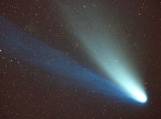
 LTEP
LTEPThe Long-Term Evolution Project studies in detail the past and future orbital evolution of the whole Short-Period Comet population. The aim of the project, carried out in close collaboration between the Planetology Branch of the Space Astrophysics Institute of CNR and the Department of Interplanetary Matter of the Astronomical Institute of the Slovak Academy of Sciences, is to create a statistically significant sample of cometary orbital evolutions.
Among the many
peculiar events found, such as close encounters and resonance trapping,
it has been possible to trace back the breakup of a cometary
nucleus, due to the striking similarity of the orbital
evolution of comets Van Biesbroeck and Neujimin 3 prior
to an encounter with Jupiter in 1850.
 MISSIONS TO COMETS
MISSIONS TO COMETSThe complex physical and dynamical evolution undergone by Short-Period comets (witnessed by the images of Halley's dark-crusted nucleus sent by the Giotto spacecraft in 1986 or the spectacular break-up of comet Shoemaker-Levy 9 around Jupiter in 1997) has put into question their consistency as representative "primitive bodies" of the Solar System. Therefore Long-Period and "new" comets can be considered as better targets for direct exploration. Unfortunately their appearances are rare and unpredictable, thus making the planning of a conventional space mission (which needs the target being known well in advance) a rather difficult task. The recent advances in small satellite and launchers technology, as well as in the sensitivity of ground based telescopes for early discovery and follow-up, allows to show that missions toward long-period and "new" comets are now in principle feasible. The LOCO (Long-Period Comet Observer) proposal addresses this problem and discusses the case of the two bright comets of 1996 and 1997 - Hale-Bopp and Hyakutake.
 references
referencesLong-Term Evolution of
Short-Period Comets. A.
Carusi, L. Kresak, E. Perozzi, G.B. Valsecchi. Adam
Hilger Ltd, Bristol and Boston, 1985. abstract
Periodic
Comets Van Biesbroek and Neujimin 3. A. Carusi, L. Kresak, E. Perozzi, G.B.
Valsecchi. IAU
Circular 3940, 1984.
The Long-Term Evolution Project. A.
Carusi, L. Kresak, E. Perozzi, G.B. Valsecchi. In proc.
'Dynamics of Comets', IAU Coll.83, A.Carusi & G.B.Valsecchi eds,
203-214, 1985.
First Results of the
Integration of Motion of Short-Period Comets over 800 years. A.
Carusi, L. Kresak, E. Perozzi, G.B. Valsecchi. In proc. 'Dynamics of
Comets'; IAU Coll.83, A.Carusi & G.B.Valsecchi eds, 319-340,
1985.
High-Order Librations
of Halley-Type Comets. A.
Carusi, L. Kresak, E. Perozzi, G.B. Valsecchi. Astronomy
& Astrophysics 187, 899-905, 1987.
On the Past Orbital History of Comet
P/Halley. A.
Carusi, L. Kresak, E. Perozzi, G.B. Valsecchi. Celestial
Mechanics 43, 319-322, 1988.
Small
Satellite Missions to Long-Period Comets. E.
Perozzi & E.M. Pittich. In
proc. 'Small Satellites Systems and Services', CNES, 181-184, 1992
Small Satellite Missions to Long-Period
Comets: The Hale-Bopp Opportunity. E.
Perozzi, G. Rondinelli, G. Di Genova, E.M. Pittich, G.B. Valsecchi.
Acta Astronautica Vol.39 No 1-4, pp
45-50, 1996.
On Targeting Long-Period and New Comets for
Small Satellite Missions. E.
Perozzi and V. Fabiani. In
proc. 'Space Exploration and Resources Exploitation - Explospace
Workshop. ESA WPP-151, P.3.1-P.3.6, 1998